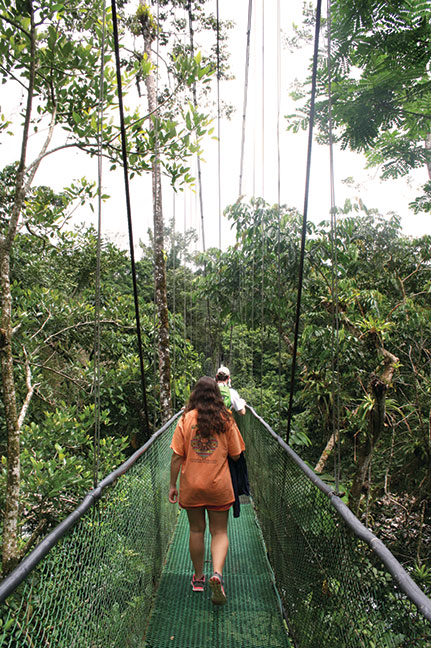Spring Breakout
Forget South Padre. Spring Break has become an intensified mini-mester of out-of-classroom learning, often overseas.

For students in the Science & Engineering course Tropical Biology, the class required a Spring Break trip to Costa Rica to fulfill the lab requirements. (Photo courtesy Hannah Wilkerson)
Spring Breakout
Forget South Padre. Spring Break has become an intensified mini-mester of out-of-classroom learning, often overseas.
When Hannah Wilkerson left for spring break in March, the last thing the biology major expected was an environmental disruption.
“Surprises came jumping out from every angle on this trip,” said Wilkerson. “Of course the most surprising of them all was being told that we would be stuck in a rainforest for an additional three days because of a volcanic eruption.”
Wilkerson wasn’t describing a scene in a movie. She was one of the students enrolled in the spring semester’s Tropical Biology course. During Spring Break, students in the class took a trip to Costa Rica to fulfill their lab requirements.
The students applied their classroom studies to the real-life species living in the Central American country. They conducted scientific research in the tropics and used their observations to write a paper at the end of the course.
Only for this year’s students, the fieldwork got a bit heated… or, at least, a little ashy when a volcano in Turrialba erupted. Smoke and ash forced the closure of nearby airports, delaying the students’ departure.
“TCU did a great job with keeping us safe and comfortable while we searched for other travel plans,” said Wilkerson.
But the Costa Rica trip was only one Spring Break adventure for students at TCU. Six other courses used the weeklong break in mid-March for an academic abroad tie-in with classwork, while two non-academic programs went overseas with a focus on service learning and leadership.
The types of abroard adventures range across areas of study. For example, in the Neeley School of Business, energy MBA students went to Europe; international business students studied in China and international marketing ventured to Peru. Students with the Global Academy went to Panama while students studying social work went to Spain.
Tracy Rundstrom Williams, associate director of the Center for International Studies, said the increase in academic spring break excursions has increased as a reflection of learning styles. “I also think this generation of learners is very hands-on and engaged and going abroad in these types of programs makes learning come to life.”
Chris White, associate professor of marketing, said the students on the trip to Peru have noted both academic and financial benefits of the programs. “Spring Break study abroad is a really good deal financially because it doesn’t require the payment of summer tuition, a substantial savings,” he said. White added that studying abroad opens doors to new experiences that can’t be replicated in the classroom.
“Having made this trip numerous times, I know in advance that the students are going to see and experience wonderful things they’ve never seen or experienced before,” said White.
Tracy Dietz, associate professor of social work, took 11 undergraduate and graduate students to Seville as part of the Comparative Social Policy course. The course explores how social problems are dealt with in different ways around the world. Students visited a community center and talked with a group of women who began a movement for affordable housing in Spain.
“It was a powerful experience for all of us,” said Dietz. “I believe more and more students understand the need to get outside of their comfort zones and learn about the world. A structured Spring Break option offers that and may be doable for students who can’t afford – time-wise or money-wise – to study abroad during the summer.”

Your comments are welcome
Comments
Related Reading:
Campus News: Alma Matters
From Application to Admission
Amid an increasingly selective admission process, Heath Einstein leads the team that builds the TCU community of the future.
Campus News: Alma Matters
From the Chancellor
Chancellor Victor J. Boschini, Jr., identifies what made TCU and its sesquicentennial so memorable.